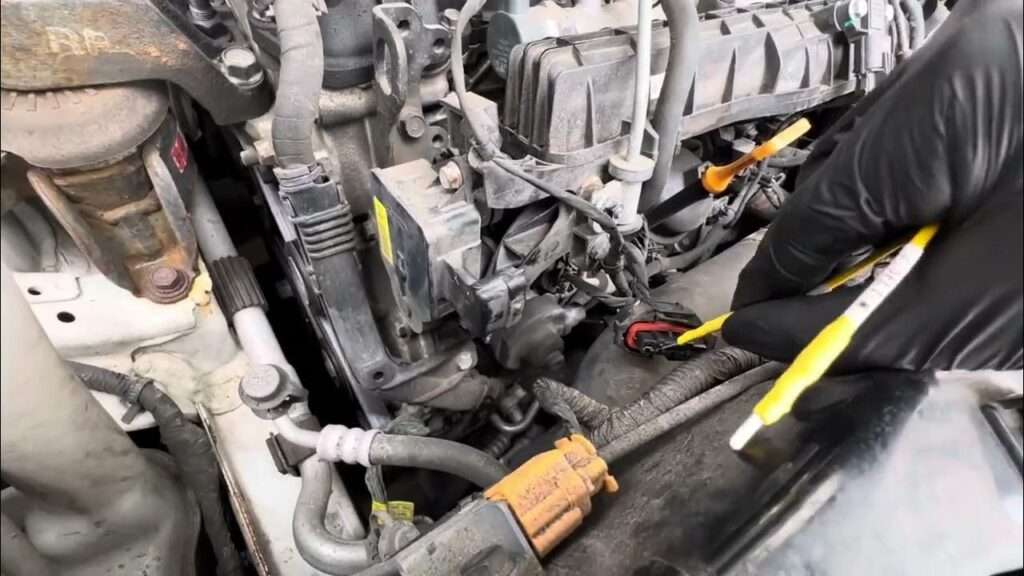
P0653 Reference Voltage Sensor Circuit “B” High
Content
P0653 – OBD-II Trouble Code Technical Description
DTC P0653 is a general trouble code that indicates the voltage on the sensor reference voltage circuit “B” is too high (compared to the manufacturer's specification).
What does the fault code mean P0653?
Trouble code P0653 indicates a high voltage on the sensor reference voltage circuit “B”. This means that the vehicle's control module has detected too high a voltage in this circuit, which may be related to various sensors such as the accelerator pedal position sensor, fuel pressure sensor, or turbocharger boost pressure sensor.

Possible reasons
Some possible reasons for the P0653 trouble code:
- Damaged or broken wires in the sensor control circuit.
- Defective accelerator pedal position sensor.
- Malfunction of the pressure sensor in the fuel system.
- Problems with the turbocharger boost pressure sensor.
- Malfunction of the engine control module (ECM) or other auxiliary control modules.
What are the symptoms of a fault code? P0653?
Symptoms when trouble code P0653 is present may include the following:
- The Check Engine (CHECK ENGINE) light on the instrument panel may illuminate.
- Failure in the accelerator control system, which may result in loss of engine power or speed limitation.
- Poor response to pressing the accelerator pedal.
- Unstable engine operation.
- Loss of engine power.
- Increased fuel consumption.
- Poor ride quality and engine performance.
These symptoms may occur to varying degrees depending on the specific conditions and nature of the problem.
How to diagnose a fault code P0653?
The following steps are recommended to diagnose DTC P0653:
- Checking the Check Engine indicator: If P0653 is present, the Check Engine light on your dashboard should illuminate. Check its functionality.
- Using the diagnostic scanner: Connect the diagnostic scanner to the OBD-II port and read the trouble codes. Make sure the P0653 code is in the error list.
- Checking the reference voltage circuit “B”: Using a multimeter, measure the voltage in circuit “B” of the reference voltage. Make sure the voltage meets the manufacturer's specifications.
- Checking circuit “B” for opens and short circuits: Check circuit “B” wiring and connectors for opens or shorts. If necessary, repair or replace the wiring.
- Checking sensors powered from circuit “B”: Check the condition and functionality of sensors supplied from circuit “B”, such as the accelerator pedal position sensor, fuel rail pressure sensor and turbocharger boost pressure sensor. If necessary, replace faulty sensors.
- PCM and ECM Check: If all of the above steps fail to identify the cause of the problem, the PCM or ECM itself may be faulty. In this case, additional diagnostics or replacement of the control module is required.
After diagnosing and eliminating the cause of the malfunction, it is recommended to clear the error codes and conduct a test drive to check the operation of the system.
Diagnostic errors
When diagnosing DTC P0653, the following errors may occur:
- Incorrect voltage measurement: If an uncalibrated or poor-quality multimeter is used to measure the voltage on the “B” circuit of the reference voltage, this may result in incorrect readings and make it difficult to determine the real cause of the problem.
- Failure to meet manufacturer specifications: If the voltage reference circuit “B” is not within manufacturer specifications, but the cause is not an open or short, the fault may be related to other components or systems in the vehicle.
- Wiring problems: Insufficient attention to checking wiring, especially in areas of possible damage or corrosion, can lead to incorrect diagnosis and missing the real cause of the problem.
- Faulty sensors: If the problem is not related to the voltage reference circuit, but the sensors powered by that circuit themselves are faulty, diagnosis may be difficult due to the incorrect focus on the power circuit.
- Faulty PCM or ECM: If all other components are checked and the problem persists, the PCM or ECM itself may be faulty, which may require replacement or reprogramming of these modules.
When diagnosing, you must be attentive to detail and ensure that all steps are carried out correctly in order to avoid mistakes and accurately determine the cause of the malfunction.
How serious is trouble code P0653?
Trouble code P0653, which indicates the sensor reference voltage "B" circuit is too high, can have varying degrees of severity depending on the specific circumstances. In general:
- Consequences for engine operation: High voltage reference circuits can cause the engine to operate incorrectly, which may result in poor performance or improper operation of the fuel injection or ignition systems.
- Possible loss of functions: Some automotive systems may go into emergency mode or fail completely due to high voltage in the reference circuit. For example, engine management systems, anti-lock brakes, turbine control and others may be affected.
- Safety: Incorrect operation of some systems, such as ABS or ESP, can affect driving safety, especially in extreme driving situations.
- Fuel consumption: Improper operation of engine management systems can result in increased fuel consumption, which can place additional financial pressure on the vehicle owner.
- Possibility of damage to other components: Continued operation at high voltage may cause additional problems in the reference circuit, which can cause serious damage to other vehicle components.
In general, the P0653 code should be considered a serious fault that requires immediate attention and diagnosis to prevent possible consequences to the safety and reliability of the vehicle.
What repair will help eliminate the code? P0653?
Troubleshooting the P0653 trouble code will depend on the specific causes that caused it. Here are some possible repair steps:
- Checking electrical connections: Check all electrical connections in the reference voltage control circuit, including connectors, wires, and pins. Make sure they are securely connected and not damaged.
- Sensor replacement: If the problem is with a specific sensor, such as the accelerator pedal position sensor, fuel rail pressure sensor, or turbocharger boost pressure sensor, then that sensor may need to be replaced.
- Control module diagnostics: Diagnose the vehicle's powertrain control module (PCM) or other auxiliary control modules to identify any malfunctions or software errors. The module may need to be reprogrammed or replaced.
- Wiring repair: If damaged wires or corroded connections are found, they should be replaced or repaired.
- Other measures: Depending on your specific circumstances, other repairs or replacement of vehicle control system components may be required.
It is important to perform a thorough diagnosis before starting repairs to avoid replacing unnecessary components and to ensure that the problem is completely corrected. If you do not have experience in automotive repair, it is recommended that you contact a qualified auto mechanic or auto repair shop for diagnosis and repair.
P0653 – Brand-specific information
Trouble code P0653 can be applied to different brands of cars, but for each brand the decoding may be slightly different, a list of some car brands with their decodings for trouble code P0653:
- Volkswagen (Volkswagen): Sensor "B" reference voltage high.
- Ford: Sensor "B" reference voltage is too high.
- Chevrolet: Sensor "B" reference voltage high.
- Toyota: Sensor “B” circuit high voltage.
- BMW: Sensor "B" reference voltage high.
- Audi (Audi): Sensor "B" reference voltage high.
- Mercedes-Benz (Mercedes-Benz): Sensor "B" reference voltage high.
- Nissan: Sensor "B" reference voltage high.
- Hyundai: Sensor "B" reference voltage high.
- Kia (Киа): Sensor "B" reference voltage high.
These are just a few examples, and the meaning of the P0653 code may vary depending on the specific model and year of the vehicle. For accurate information, it is recommended that you consult the repair manual for your specific vehicle make and model or contact an authorized service center.

One comment
Machine Moussa
Where is located this sensor b code p0653